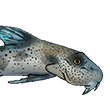/siluriformes/loricariidae/pterygoplichthys/pardalis/1.jpg)
/siluriformes/loricariidae/pterygoplichthys/pardalis/2.jpg)
/siluriformes/loricariidae/pterygoplichthys/pardalis/3.jpg) Close-up of mouth
Close-up of mouth/siluriformes/loricariidae/pterygoplichthys/pardalis/4.jpg) Close-up of head
Close-up of head/siluriformes/loricariidae/pterygoplichthys/pardalis/5.jpg) Albino
Albino/siluriformes/loricariidae/pterygoplichthys/pardalis/6.jpg)
/siluriformes/loricariidae/pterygoplichthys/pardalis/7.jpg) Dorsal view from above water
Dorsal view from above water/siluriformes/loricariidae/pterygoplichthys/pardalis/8.jpg) Dorsal view
Dorsal view/siluriformes/loricariidae/pterygoplichthys/pardalis/9.jpg) Frontal view
Frontal view/siluriformes/loricariidae/pterygoplichthys/pardalis/10.jpg) Albino
Albino/siluriformes/loricariidae/pterygoplichthys/pardalis/11.jpg)
/siluriformes/loricariidae/pterygoplichthys/pardalis/12.jpg)
/siluriformes/loricariidae/pterygoplichthys/pardalis/13.jpg)
/siluriformes/loricariidae/pterygoplichthys/pardalis/14.jpg) Adult
Adult/siluriformes/loricariidae/pterygoplichthys/pardalis/15.jpg) Close-up of head
Close-up of head/siluriformes/loricariidae/pterygoplichthys/pardalis/16.jpg)
/siluriformes/loricariidae/pterygoplichthys/pardalis/17.jpg)
/siluriformes/loricariidae/pterygoplichthys/pardalis/18.jpg) Newly laid eggs
Newly laid eggs/siluriformes/loricariidae/pterygoplichthys/pardalis/19.jpg) Two day old eggs
Two day old eggs/siluriformes/loricariidae/pterygoplichthys/pardalis/20.jpg) Four day old eggs
Four day old eggs/siluriformes/loricariidae/pterygoplichthys/pardalis/21.jpg) Newly hatched fry
Newly hatched fry/siluriformes/loricariidae/pterygoplichthys/pardalis/22.jpg) One day old fry
One day old fry/siluriformes/loricariidae/pterygoplichthys/pardalis/23.jpg) Two day old fry
Two day old fry/siluriformes/loricariidae/pterygoplichthys/pardalis/24.jpg) Three day old fry
Three day old fry/siluriformes/loricariidae/pterygoplichthys/pardalis/25.jpg) Four day old fry
Four day old fry/siluriformes/loricariidae/pterygoplichthys/pardalis/26.jpg) Five day old fry
Five day old fry/siluriformes/loricariidae/pterygoplichthys/pardalis/27.jpg) Six day old fry
Six day old fry/siluriformes/loricariidae/pterygoplichthys/pardalis/28.jpg) Week old fry
Week old fry/siluriformes/loricariidae/pterygoplichthys/pardalis/29.jpg) Three week old juvenile
Three week old juvenile/siluriformes/loricariidae/pterygoplichthys/pardalis/30.jpg) Sub-adult
Sub-adult
| Scientific Name | Pterygoplichthys pardalis (Castelnau, 1855) |
| Common Names | L021, Common Pleco L023, Albino Pleco, Amazon Sailfin Pleco, Chocolate Pleco, Janitor Fish, Pantersugemalle (Denmark) |
| Type Locality | Amazon River, Brazil. |
| Synonym(s) | Hypostomus pardalis, Liposarcus jeanesianus, Liposarcus pardalis, Liposarcus varius |
| Pronunciation | terry gop LICK thees - par dah liss |
| Etymology | Greek, pterygion, diminutive of pteryx = wing, fin + Greek, hoplon = weapon + Greek, ichthys = fish. |
| Articles | |
| Size | 423mm or 16.7" SL. Find near, nearer or same sized spp. |
| Identification | Pterygoplichthys can be identified by the number of rays in the dorsal fin. Ten or more dorsal rays (usually more than 10) indicates that it's a Pterygoplichthys. Most other plecos have 8 or fewer rays (in particular the larger Hypostomus species that are most likely to be confused with Pterygoplichthys). Is also L023. A relatively nondescript species that is unlikely to be imported as an L number. An amelanistic form has also been fixed by US and SE Asian commercial fish farms and is commonly sold as the "chocolate pleco". As they are bred in huge numbers by commercial fish farms, this is currently the most commonly available loricariid and can be found for sale in nearly all the larger chain-type pet stores. This species is most likely to be confused with P. disjunctivus. The pattern on the abdomen is the most useful external key: P. pardalis has a spotted pattern, where P. disjunctivus has a vermiculated pattern. For more info see: Zootaxa 1109: 57-68 (2006) |
| Sexing | Comparison of the genital papilla in mature fish shows the differences in the sexes to the trained eye. In males this is a small yet thick stump which noticeably protrudes from the fish's undercarriage. In females it is less obvious and is recessed or lies flat with the body. |
| General Remarks | It is important to note that the term "common pleco" is applied to several nondescript loricariid species, especially of the genera Pterygoplichthys and Hypostomus. |
| Distribution | South America: Lower, middle and upper Amazon River basin. Introduced to countries outside its native range. Amazon (click on these areas to find other species found there) Login to view the map. |
| IUCN Red List Category | Least Concern , range map and more is available on the IUCN species page. Last assessed 2020. |
| pH | 6.0 - 7.5 |
| Temperature | 21.0-26.0°C or 69.8-78.8°F (Show species within this range) |
| Other Parameters | Typically specimens found for sale are pond bred and raised and hardy. They will adapt to most water conditions and extend the more optimal ranges given here. |
| Feeding | |
| Furniture | Larger fish will unwittingly uproot plants. Large plastic or ceramic pipes are best for hiding places. |
| Compatibility | Peaceful as far as large plecos go. |
| Suggested Tankmates | Almost any medium sized community fish. |
| Breeding | Commercially bred in outdoor ponds in both the U.S. and Far East. |
| Breeding Reports | There is no breeding report. |
| Reference | Animaux nouveaux or rares v. 2, pp42, Pl. 20 (fig. 3). |
| Registered Keepers | There are 367 registered keepers, view all "my cats" data. |
| Wishlists | Love this species? Click the heart to add it to your wish list. There are 4 wishes to keep this species, see who wants what. |
| Spotters | Spotted this species somewhere? Click the binoculars! There are 49 records of this fish being seen, view them all. |
| Forum BBCode | |
| Search for P. pardalis | |
| Look up P. pardalis on AquaticRepublic.com | |
 | Look up P. pardalis on Fishbase |
 | Look up P. pardalis on Encyclopedia of Life |
 | Look up P. pardalis on Global Biodiversity Information Facility |
| LFS label creator ARN ref:1.4.6.88 | |
| Last Update | 2025 Jan 02 01:37 (species record created: 2001 May 05 00:00) |




